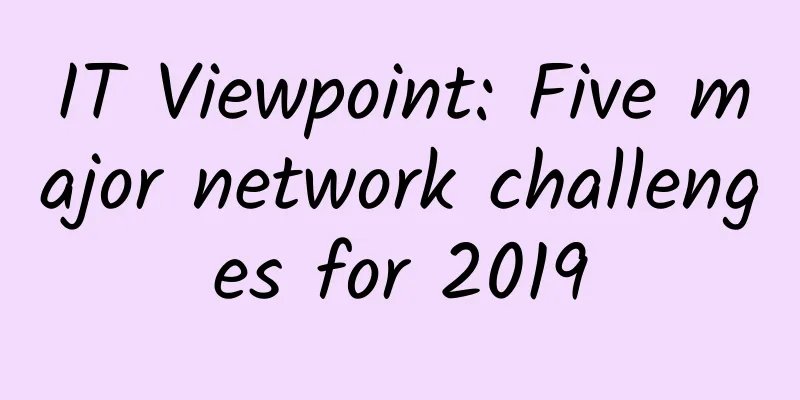IT Viewpoint: Five major network challenges for 2019

|
Frank Scalzo, network director at data center operator Iron Mountain, pointed out that today's IT industry is changing, and enterprise network engineers and architects are facing a series of challenges. As business needs evolve and networks become more complex, these changes may be difficult to cope with. So, what are the main networking challenges facing engineers and architects in the data center industry?
1. Network capacity Network capacity is a significant issue for all parties involved in providing network solutions. Today’s companies are dealing with increasing amounts of data generated by data sources. The proliferation of video content is a significant factor, as is the increasing number of IoT devices deployed, which are generating more and more data. Companies also need to deal with the monetization of data. Many new business models are not centered around selling products, but rather around monetizing and productizing information. Therefore, the demand for network capacity will continue to grow. Industry experts have given many network predictions. And, this is not because network engineers are looking for more ways to invest, but because people will always need to find a way to use the available connection and communication resources. Industry trends like big data and video continue to grow, but there is always something else going on. For example, sensors for smart car sharing and communications or supply chain logistics, and field or industrial control sensors in manufacturing plants. For the foreseeable future, there will be no use cases that drive network capacity requirements. In addition to changing capacity requirements, networks must scale to respond to evolving security threats. As people become more dependent on data and online services, tolerance for downtime or poorly performing networks has dropped dramatically. Data replication and protection strategies are critical to businesses. Many companies have discovered that they can scale more cost-effectively and gain efficiencies by moving their IT infrastructure to a third-party colocation data center. 2. Scalability Fortunately for end users, bandwidth is becoming less expensive as demand surges. The challenge for enterprises is how to scale infrastructure on demand to stay ahead of demand while maximizing financial efficiency. For example, organizations deploying IT assets in corporate offices face cost inefficiencies associated with local loop telecommunications services. This requires rapid scale-up. Many companies have discovered that by moving their IT infrastructure to a third-party colocation data center, they can scale more cost-effectively and gain efficiencies. Despite the growing demand for network capacity, scalability, redundancy and data replication, these organizations are better able to reduce network operating costs. It is important for network vendors to choose data center partners that can scale with them. Many companies do not consider expansion until they are locked into an environment, and therefore face huge switching costs. Iron Mountain's focus is on bringing data center customers into the ecosystem, where they can effectively scale network and data center capacity to meet hyperscale needs. 3. Cloud Migration Cloud migration is a challenge facing many organizations today. By moving operations to the cloud, organizations are actually outsourcing work from the operating system level and running their applications on a virtualization platform provided by a third party. Organizations must decide which data, applications, and business logic run in the cloud and which do not. This also includes a whole new paradigm for evaluating security, compliance, and control tasks. Data migration and extraction are key considerations in any cloud migration strategy. This includes managing access and cloud-to-on-premises data center connectivity. Many organizations will have evolving strategies around when to use public cloud versus when to use private cloud, and in all cases, the connections that bridge hybrid IT deployments will be critical. 4. Security There are three main pillars of information security: confidentiality, integrity, and availability of information. When looking at these, you need to consider who you work with and what methods you use to achieve this. Capacity and scalability help organizations achieve their goals. Physical security can impact all three of these aspects. Physical security is a topic that many organizations overlook. They may have a strong plan in place for cybersecurity, but physical access to devices is also important. A failure in physical security can impact the confidentiality, integrity, and availability of data. Managing physical security can be a challenging issue for some organizations. That’s where having a reliable data center partner is key. Organizations need to evaluate and consider not only their own data protection practices, but also those of each of their suppliers and partners. 5. Compliance Privacy is front and center in most compliance programs today. Many organizations are struggling to figure out how the new privacy law requirements will impact their compliance programs and IT strategies. There hasn’t been a lot of case law created around GDPR, but a fine of 4% of a company’s revenue is pretty significant, so it’s easy to understand why companies are worried. Another trend we are seeing is a greater emphasis on supply chain integrity management. This means that your suppliers need to be more diligent. Organizations need to evaluate and consider not only their own data protection practices, but also the data protection practices of each supplier and partner. Organizations need partners they can trust to hold and manage this data, as well as the corresponding contract terms. For some organizations, onboarding a new vendor can take as long as 12 to 18 months due to the diligence required to vet a new vendor from a compliance and audit perspective. As a result, some organizations have reduced the number of vendors they work with, buying more services from fewer companies. These are just some of the issues facing network engineers and architects today, but there has never been a better time to tackle challenges like these because the market has provided several solutions to help organizations solve the problems, and it’s an exciting time with dynamic challenges and solutions. |
<<: Are you still pinging? 7 advanced methods to help you quickly test port connectivity
>>: The first batch of commercial 5G networks may not even be able to make phone calls?
Recommend
Exploring the core idea of the Reactor network model
In the network programming series, we implemented...
What is AirGig?
At the MWC 2017 conference, which has ended, peop...
In the 5G era, operators are fully advancing cloud-network integration
At the same time, with the large-scale commercial...
Yecao Cloud: Hong Kong dedicated server from 299 yuan/month, Hong Kong VPS annual payment from 138 yuan
Yecao Cloud is a Chinese hosting company founded ...
iPhone 12 is coming! What else is there to look forward to besides the new phone?
[[344926]] Apple said on Tuesday that it will hol...
RackNerd Cyber Monday special VPS starts at $8.49 per year, multiple data centers available
Black Friday is followed by Cyber Monday, and t...
From the user's perspective: the battle between Ethernet color light and PON
The park is the "central battlefield" f...
Can 5G enable remote surgery?
In the early days of 5G, we often saw various hig...
"Number Portability" has been officially launched! Netizens complain: The operators are full of tricks!
Some time ago, the Ministry of Industry and Infor...
The origin and development of Ethernet, you will understand after reading this!
Basics 1. About Ethernet Ethernet was developed b...
Architecture Design: Sidecar Pattern Explained
Context and Questions Modern applications usually...
Virtono: €23.7/year KVM-2GB/25GB/2TB/Los Angeles & Dallas & New York & Romania, etc.
Virtono recently launched a summer promotion, off...
Foreign media said that the number of 5G base stations in Shenzhen has exceeded that of Germany by 50 times
According to foreign media, Germany's Handels...
The cybersecurity industry developed rapidly in 2021, and Xinglan Technology achieved outstanding results in the new track of API security
With the rise of emerging technologies such as cl...
Is this another money-making game? Why are you urging me to switch to 5G when 4G is so good?
At present, the number of 4G users in my country ...









